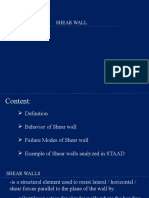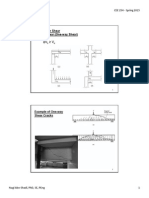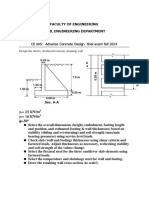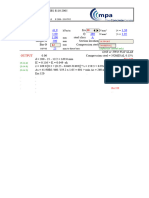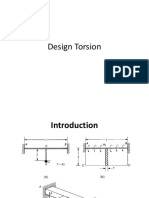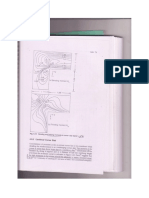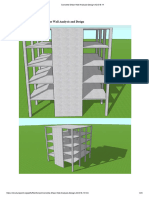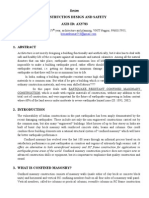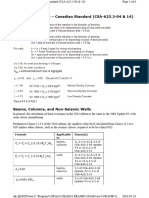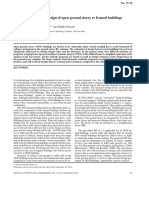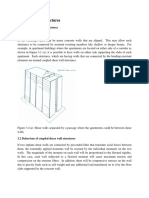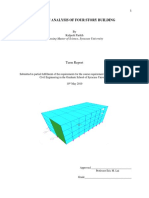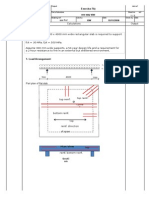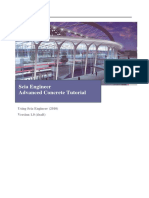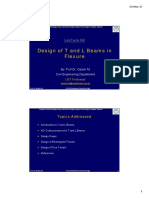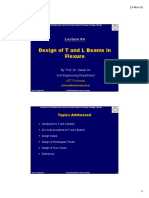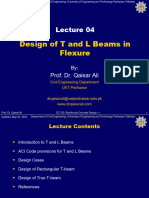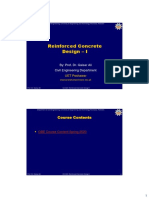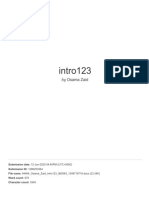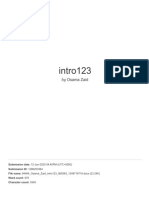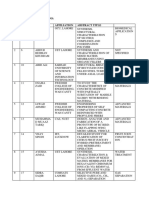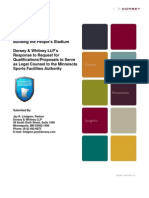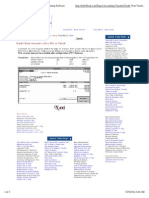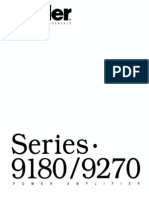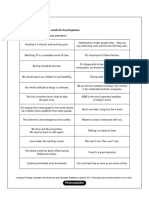5/7/2020
Department of Civil Engineering, University of Engineering and Technology Peshawar, Pakistan
Lecture 04
Design of T and L Beams in
Flexure
By: Prof. Dr. Qaisar Ali
Civil Engineering Department
UET Peshawar
drqaisarali@uetpeshawar.edu.pk
Prof. Dr. Qaisar Ali CE 320 Reinforced Concrete Design
Department of Civil Engineering, University of Engineering and Technology Peshawar, Pakistan
Topics Addressed
Introduction to T and L Beams
ACI Code provisions for T and L Beams
Design Cases
Design of Rectangular T-beam
Design of True T-beam
References
Prof. Dr. Qaisar Ali CE 320 Reinforced Concrete Design 2
1
� 5/7/2020
Department of Civil Engineering, University of Engineering and Technology Peshawar, Pakistan
Objectives
At the end of this lecture, students will be able to;
Differentiate between T-beam and L-beam
Explain Mechanics of Rectangular T-beam and true T-beam
Design T-beam for flexure
Prof. Dr. Qaisar Ali CE 320 Reinforced Concrete Design 3
Department of Civil Engineering, University of Engineering and Technology Peshawar, Pakistan
Introduction to T and L Beam
The T or L Beam gets its name when the slab and beam produce
the cross sections having the typical T and L shapes in a monolithic
reinforced concrete construction.
Prof. Dr. Qaisar Ali CE 320 Reinforced Concrete Design 4
2
� 5/7/2020
Department of Civil Engineering, University of Engineering and Technology Peshawar, Pakistan
Introduction to T and L Beam
In casting of reinforced concrete floors/roofs, forms are built for
beam sides, the underside of slabs, and the entire concrete is
mostly poured at once, from the bottom of the deepest beam to the
top of the slab.
Prof. Dr. Qaisar Ali CE 320 Reinforced Concrete Design 5
Department of Civil Engineering, University of Engineering and Technology Peshawar, Pakistan
Introduction to T and L Beam
Prof. Dr. Qaisar Ali CE 320 Reinforced Concrete Design 6
3
� 5/7/2020
Department of Civil Engineering, University of Engineering and Technology Peshawar, Pakistan
Introduction to T and L Beam
Prof. Dr. Qaisar Ali CE 320 Reinforced Concrete Design 7
Department of Civil Engineering, University of Engineering and Technology Peshawar, Pakistan
Introduction to T and L Beam
Prof. Dr. Qaisar Ali CE 320 Reinforced Concrete Design 8
4
� 5/7/2020
Department of Civil Engineering, University of Engineering and Technology Peshawar, Pakistan
Introduction to T and L Beam
a b a
a b a
a b a
a b a
Compression
Tension
Tension Compression
Section a-a Section b-b
Prof. Dr. Qaisar Ali CE 320 Reinforced Concrete Design 9
Department of Civil Engineering, University of Engineering and Technology Peshawar, Pakistan
Introduction to T and L Beam
Positive Bending Moment
In the analysis and design of floor and roof systems, it is common practice
to assume that the monolithically placed slab and supporting beam
interact as a unit in resisting the positive bending moment.
As shown, the slab becomes the compression flange, while the supporting
beam becomes the web or stem.
Flange
Compression
Tension
Web
Section a-a
Prof. Dr. Qaisar Ali CE 320 Reinforced Concrete Design 10
5
� 5/7/2020
Department of Civil Engineering, University of Engineering and Technology Peshawar, Pakistan
Introduction to T and L Beam
Negative Bending Moment
In the case of negative bending moment, the slab at the top of the stem
(web) will be in tension, while the bottom of the stem will be in
compression. This usually occurs at interior support of continuous beam.
Tension
Compression
Section b-b
Prof. Dr. Qaisar Ali CE 320 Reinforced Concrete Design 11
Department of Civil Engineering, University of Engineering and Technology Peshawar, Pakistan
ACI Code Provisions for T and L Beams
For T and L beams supporting monolithic or composite slabs, the effective
flange width bf shall include the beam web width bw plus an effective
overhanging flange width in accordance with ACI 318-19 Table 6.3.2.1.
Slab Effective Flange Width
bf bf
hf
Flange
Web or Stem
sw
bw
Prof. Dr. Qaisar Ali CE 320 Reinforced Concrete Design 12
6
� 5/7/2020
Department of Civil Engineering, University of Engineering and Technology Peshawar, Pakistan
ACI Code Provisions for T and L Beams
Calculation of Effective Flange Width (bf) (ACI 318-19, 6.3.2.1)
T - Beam
1 bw + 16hf
sw sw
2 bw + sw
Least of the above values is selected as bf
3 bw + ℓn/4
Note: In ACI 318-19 (6.3.2.1), h is used for
Where,
slab thickness, while in ACI 318-19
bw = Width of the beam; (9.3.1.1), h is used for beam depth.
hf = Slab thickness; However, in this lecture, for differentiation
sw = Clear distance to the adjacent beam; between beam depth and slab thickness, hf
ℓn = Clear length of beam. will be used to denote slab thickness.
Prof. Dr. Qaisar Ali CE 320 Reinforced Concrete Design 13
Department of Civil Engineering, University of Engineering and Technology Peshawar, Pakistan
ACI Code Provisions for T and L Beams
Calculation of Effective Flange Width (bf) (ACI 6.3.2.1)
L - Beam Effective Flange Width
bf Slab
bf
1 bw + 6hf hf
Flange
2 bw + sw/2 Web or Stem
ssw
bw
3 bw + ℓn/12 w
w
Least of the above values is selected as bf
Prof. Dr. Qaisar Ali CE 320 Reinforced Concrete Design 14
7
� 5/7/2020
Department of Civil Engineering, University of Engineering and Technology Peshawar, Pakistan
Design Cases
In designing a T-Beam for positive bending moment, there exists two
conditions:
Case 1. The depth of the compression block may be less than or equal to
the slab depth i.e. flange thickness (a ≤ hf)
In such a condition the T-Beam is designed as rectangular beam for positive
bending with the width of compression block equal to bf.
bf
a hf
d N.A
As
bw
Prof. Dr. Qaisar Ali CE 320 Reinforced Concrete Design 15
Department of Civil Engineering, University of Engineering and Technology Peshawar, Pakistan
Design Cases
Case 2. The compression block cover the flange and extend into the web (a ˃ hf)
In such condition the T-Beam is designed as true T-beam.
(bf - bw)/2
bf
hf
a
d N.A
Ast
bw
Prof. Dr. Qaisar Ali CE 320 Reinforced Concrete Design 16
8
� 5/7/2020
Department of Civil Engineering, University of Engineering and Technology Peshawar, Pakistan
Design of Rectangular T-beam
Flexural Capacity
Case 1. When a ≤ hf
bf
a hf
d N.A
As
bw
Prof. Dr. Qaisar Ali CE 320 Reinforced Concrete Design 17
Department of Civil Engineering, University of Engineering and Technology Peshawar, Pakistan
Design of Rectangular T-beam
Flexural Capacity
bf εc 0.85fc ′
a/2
(∑Fx = 0) a hf a C
N.A
0.85fc′ abf = Asfy d la = (d - a/2)
a = Asfy/ 0.85fc′ bf As
εs
T
(∑M = 0) bw
Mn = T*la = Asfy (d – a/2)
As ΦMn = Mu ; ΦAsfy (d – a/2) = Mu
Therefore, As = Mu/Φfy(d – a/2)
The other checks remain same as that of rectangular beam design.
Note: In calculating Asmax and Asmin, use bw , not bf.
Prof. Dr. Qaisar Ali CE 320 Reinforced Concrete Design 18
9
� 5/7/2020
Department of Civil Engineering, University of Engineering and Technology Peshawar, Pakistan
Design of Rectangular T-beam
Example 01
The roof of a hall has a 5″ thick slab with beams having 30 feet. c/c and
28.5 feet clear length. The beams are having 9 feet clear spacing and
have been cast monolithically with slab. Overall depth of beam (including
slab thickness) being 24 in. and width of beam web being 14 in. Calculate
the steel reinforcement area for the simply supported beam against a
total factored load (including self weight of beam) of 3 k/ft. Use fc′ = 3 ksi
and fy = 60 ksi.
Prof. Dr. Qaisar Ali CE 320 Reinforced Concrete Design 19`
Department of Civil Engineering, University of Engineering and Technology Peshawar, Pakistan
Design of Rectangular T-beam
Solution:
Span length (lc/c) = 30′ ; clear length (ln) = 28.5′
W u = 3 k/ft
d = 24-2.5 = 21.5″, bw = 14″; hf = 5″
5″
Effective flange width (bf) is minimum of,
21.5″
bw + 16hf = 14 + 16 × 5 = 94″ 19″
As
bw + sw = 14 + 9 × 12 = 122″
bw + ln/4 + = 14 + 28.5 × 12/4 = 99.5″ 14″
Therefore, bf = 94″
Prof. Dr. Qaisar Ali CE 320 Reinforced Concrete Design 20
10
� 5/7/2020
Department of Civil Engineering, University of Engineering and Technology Peshawar, Pakistan
Design of Rectangular T-beam
Solution:
Check if the beam behaviour is T or rectangular.
Mu = wulc/c 2/8 = 3 x 302 x12 / 8 = 4050 in-kips
Trial # 01
Let a = hf = 5″
As = Mu/Φfy(d – a/2) = 4050/{0.90 × 60 × (21.5 – 5/2)} = 3.94 in2
Trial # 02
a = Asfy/(0.85fc′bf) = 3.94 × 60/ (0.85 × 3 × 94) = 0.98″ ˂ hf = 5″
Therefore, design as Rectangular beam.
As = Mu/Φfy(d – a/2) = 4050/{0.90 × 60 × (21.5 – 0.98/2)} = 3.56 in2
Prof. Dr. Qaisar Ali CE 320 Reinforced Concrete Design 21
Department of Civil Engineering, University of Engineering and Technology Peshawar, Pakistan
Design of Rectangular T-beam
Solution:
Trial # 03
a = Asfy/(0.85fc′bf) = 3.56 × 60/ (0.85 × 3 × 94) = 0.89″
As = Mu/Φfy(d – a/2) = 4050/{0.90 × 60 × (21.5 – 0.89/2)} = 3.56 in2
Therefore As = 3.56 in2
Try #8 bars, No of Bars = 3.56 / 0.8 = 4.45, say 5 bars
Prof. Dr. Qaisar Ali CE 320 Reinforced Concrete Design 22
11
� 5/7/2020
Department of Civil Engineering, University of Engineering and Technology Peshawar, Pakistan
Design of Rectangular T-beam
Solution:
Check for maximum and minimum reinforcement allowed by ACI:
Asmin = 3 ( fc′/ fy) bwd ≥ (200/fy) bwd ; (Greater of these two for fy ≤ 80 ksi)
3 ( fc′ /fy) bwd = 3 × ( 3000 /60000) bwd = 0.82 in2
(200/fy) bwd = (200/60000) x 14 × 21.5 = 1.0 in2
Therefore, Asmin = 1.0 in2
Asmax = 0.27 (fc′ / fy) bwd = 0.27 x (3/60) x 14 × 21.5 = 4.06 in2
Asmin (1.0) < As (4.0) < Asmax (4.06) O.K!
Prof. Dr. Qaisar Ali CE 320 Reinforced Concrete Design 23
Department of Civil Engineering, University of Engineering and Technology Peshawar, Pakistan
Design of Rectangular T-beam
Drafting
bf = 94″
5″
24″
(3+2),#8 bars
bw =14″
Prof. Dr. Qaisar Ali CE 320 Reinforced Concrete Design 24
12
� 5/7/2020
Department of Civil Engineering, University of Engineering and Technology Peshawar, Pakistan
Design of Rectangular T-beam
Class Activity: Design the Beam B1 for the following moments
fc′ = 4 ksi, fy = 60 ksi, beam web width = 15′′, Slab thickness = 6′′
Overall beam depth (including slab thickness) = 24′′,
1764 ′′ K 1764 ′′ K
24′ clear length 24′ clear length
3122 ′′ K B1-Moment Diagram
Prof. Dr. Qaisar Ali CE 320 Reinforced Concrete Design 25
Department of Civil Engineering, University of Engineering and Technology Peshawar, Pakistan
Design of True T-beam
Flexural Capacity
Case 2. When a > hf
(bf -bw)/2 (bf -bw)/2
bf bf bf
hf hf
a a
d d d N.A
= +
Ast Asf As
bw bw
bw
ΦMn ΦMn1 ΦMn2
ΦMn = ΦMn1 + ΦMn2
Prof. Dr. Qaisar Ali CE 320 Reinforced Concrete Design 26
13
� 5/7/2020
Department of Civil Engineering, University of Engineering and Technology Peshawar, Pakistan
Design of True T-beam
(bf -bw)/2
Flexural Capacity bf
hf/2
ΦMn1 Calculation: hf C1
N.A
From stress diagram d l1 = d - hf/2
T1 = C1 Asf
T1
C1 = 0.85 fc′ (bf - bw)hf bw
ΦMn1
T1 = Asf fy
Asf fy = 0.85fc′ (bf - bw)hf
Everything in the equation is known except Asf
Therefore, Asf = 0.85fc′ (bf - bw)hf / fy
ΦMn1 = T1 x l1 = ΦAsf fy (d – hf/2)
Prof. Dr. Qaisar Ali CE 320 Reinforced Concrete Design 27
Department of Civil Engineering, University of Engineering and Technology Peshawar, Pakistan
Design of True T-beam
Flexural Capacity (bf -bw)/2
bf
ΦMn2 Calculation:
hf a
a/2
C2
From stress diagram N.A
d
T2 = C2
l2 = d - a/2
As
T2
C2 = 0.85 fc′ abw
bw ΦMn2
T2 = As fy
As fy = 0.85fc′ abw
a = As fy / (0.85 fc′ bw)
ΦMn2 = T2 x l2 = Φ As fy (d – a/2)
Prof. Dr. Qaisar Ali CE 320 Reinforced Concrete Design 28
14
� 5/7/2020
Department of Civil Engineering, University of Engineering and Technology Peshawar, Pakistan
Design of True T-beam
As Calculation (bf -
bbfw)/2
h a
a/2
C2
We know that ΦMn = Mu f N.A
d
ΦMn1 + ΦMn2 = Mu l2 = d - a/2
As
ΦMn1 is already known to us, T2
Therefore ΦMn2 = Mu – ΦMn1 b ΦMn2
w
And as, ΦMn2 = T2 x l2 = Φ As fy (d – a/2)
Also ΦMn2 = Mu – ΦMn1
Therefore, As = (Mu – ΦMn1)/ Φfy (d – a/2);
and a = As fy / (0.85 fc′ bw)
Calculate As by trial and success method.
Prof. Dr. Qaisar Ali CE 320 Reinforced Concrete Design 29
Department of Civil Engineering, University of Engineering and Technology Peshawar, Pakistan
Design of True T-beam
Ductility Requirements • For fy = 40 ksi
c = 0.41d and, a = β1c = β10.41d
• For fy = 60 ksi
T = C1 + C2 [ ∑Fx = 0 ] c = 0.37d and, a = β1c = β10.37d
Astfy =0.85fc′(bf – bw)hf + 0.85fc′abw
Astfy = Asffy + 0.85fc′abw
For ductility εs = εt = εty + 0.003 (ACI 318-19 table 21.2.2)
For a = β1c, Ast will become Astmax, Therefore,
Astmax fy= 0.85fc′β1cbw + Asffy (For fc′ ≤ 4000 psi, β1 = 0.85)
Astmax = 0.27 (fc′/ fy) bwd + Asf (fy =60 ksi), Astmax = 0.3 (fc′/ fy) bwd + Asf (fy =40 ksi)
Alternatively Astmax (True T beam) = Asmax (singly) + Asf
So, for T-beam to behave in a ductile manner Ast, provided ≤ Astmax (True T beam)
Prof. Dr. Qaisar Ali CE 320 Reinforced Concrete Design 30
15
� 5/7/2020
Department of Civil Engineering, University of Engineering and Technology Peshawar, Pakistan
Design of True T-beam
Example 02
Design a simply supported T beam to resist a factored positive moment
equal to 6700 in-kip. The beam is 12″ wide and is having 24″ total depth
including a slab thickness of 3 inches. The centre to centre and clear
lengths of the beam are 25.5′ and 24′ respectively. The clear spacing
between the adjacent beams is 3 ft. Take fc′ = 3 ksi and fy = 60 ksi.
Prof. Dr. Qaisar Ali CE 320 Reinforced Concrete Design 31
Department of Civil Engineering, University of Engineering and Technology Peshawar, Pakistan
Design of True T-beam
Solution:
Span length (lc/c) = 25.5′ ; clear length (ln) = 24′
d = 21.5″; bw = 12″; hf = 3″
Effective flange width (bf) is minimum of,
bw + 16hf = 12 + 16 × 3 = 60″
bw + sw = 12 + 3 × 12 = 48″
bw + ln/4 = 12 + 24 × 12/4 = 84″
Therefore, bf = 48″
Prof. Dr. Qaisar Ali CE 320 Reinforced Concrete Design 32
16
� 5/7/2020
Department of Civil Engineering, University of Engineering and Technology Peshawar, Pakistan
Design of True T-beam
Solution:
Check if the beam behaviour is T or rectangular.
Let a = hf = 3″
As = Mu/Φfy(d – a/2) = 6700/{0.90 × 60 × (21.5 – 3/2)} = 6.203 in2
a = Asfy/(0.85fc′bf) = 6.203 × 60/ (0.85 × 3 × 48) = 3.041″ > hf
Therefore, design as True T-beam.
Prof. Dr. Qaisar Ali CE 320 Reinforced Concrete Design 33
Department of Civil Engineering, University of Engineering and Technology Peshawar, Pakistan
Design of True T-beam
Solution:
Design:
Calculate Asf
Asf = 0.85fc′ (bf – bw) hf/fy
= 0.85 × 3 × (48 – 12) × 3/60 = 4.59 in2
The nominal moment resistance (ФMn1), provided by Asf is,
ФMn1 = ФAsf fy {d – hf/2} = 0.9 × 4.59 × 60 × {21.5 – 3/2} = 4957.2 in-kip
Prof. Dr. Qaisar Ali CE 320 Reinforced Concrete Design 34
17
� 5/7/2020
Department of Civil Engineering, University of Engineering and Technology Peshawar, Pakistan
Design of True T-beam
Solution:
Design:
The nominal moment resistance (ФMn2), provided by remaining steel As is,
ФMn2 = Mu – ФMn1 = 6700 – 4957.2 = 1742.8 in-kip
Let a = 0.2d = 0.2 × 21.5 = 4.3″
As = ФMn2/ {Фfy(d – a/2)} = 1742.8 / {0.9 × 60 × (21.5 – 4.3/2)}= 1.667 in2
a = Asfy/(0.85fc′bw) = 1.667 × 60 / (0.85 × 3 ×12) = 3.27″
By trial and success method, finally As= 1.62 in2
Ast = Asf + As = 4.59 + 1.62 = 6.21 in2 (Use 9, #8 Bars)
Ast(Provided) = 9 x 0.8 = 7.2 in2
Prof. Dr. Qaisar Ali CE 320 Reinforced Concrete Design 35
Department of Civil Engineering, University of Engineering and Technology Peshawar, Pakistan
Design of True T-beam
Solution:
Ductility requirements, Asmin ≤ (Ast = As + Asf) ≤ Astmax (True T-Beam)
Asmin = 3 ( fc′/ fy) bwd ≥ (200/fy) bwd (for fy ≤ 80 ksi)
3 ( fc′/ fy) bwd = 3 × (√(3000)/60000) x 12 x 21.5 = 0.706 in2
200/fy bw d = (200/60000) x 12 x 21.5 = 0.86 in2
Asmax (singly) =0.27(fc′/fy)bd = 0.27x(3/60)x12x21.5 = 3.48 in2
Astmax (True T- Beam) = Asmax (singly) + Asf = 3.48 + 4.59 = 8.07 in2
Asmin (0.8) < Ast(provided) (7.2) < Astmax (True T- Beam) (8.07) , O.K.
Prof. Dr. Qaisar Ali CE 320 Reinforced Concrete Design 36
18
� 5/7/2020
Department of Civil Engineering, University of Engineering and Technology Peshawar, Pakistan
Design of True T-beam
Solution: (Class Activity)
Check design capacity your self.
Prof. Dr. Qaisar Ali CE 320 Reinforced Concrete Design 37
Department of Civil Engineering, University of Engineering and Technology Peshawar, Pakistan
Design of True T-beam
Drafting:
bf =48″
3″
d=19.125″
(3+3+3),#8 bars
bw =12″
Prof. Dr. Qaisar Ali CE 320 Reinforced Concrete Design 38
19
� 5/7/2020
Department of Civil Engineering, University of Engineering and Technology Peshawar, Pakistan
References
Design of Concrete Structures 14th Ed. by Nilson, Darwin and Dolan.
Building Code Requirements for Structural Concrete (ACI 318-19)
Prof. Dr. Qaisar Ali CE 320 Reinforced Concrete Design 39
20
